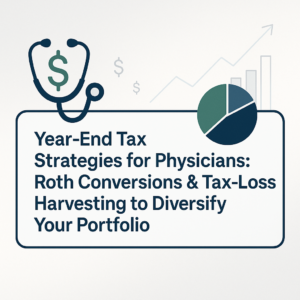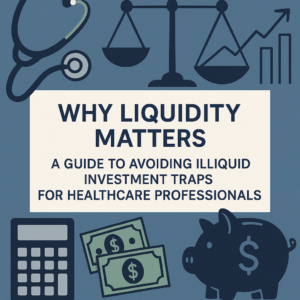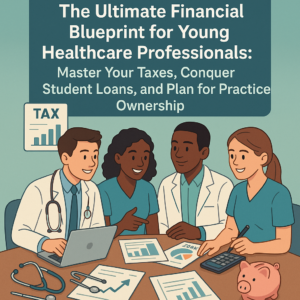Building Financial Stability: Essential Financial Planning Tips for Young Healthcare Professionals
Congratulations on embarking upon a rewarding career in healthcare! As a physician, dentist, pharmacist, physical therapist, or psychologist, you’re stepping into a role that places you at the forefront of improving lives. While your profession focuses on the well-being of others, it’s equally important to prioritize your own financial health. Navigating the financial landscape can be challenging, especially with the unique circumstances that healthcare professionals often face. This comprehensive guide aims to provide you with the tools and knowledge to build a secure financial future.
Understanding Your Financial Landscape
Financial planning begins with a thorough understanding of your current financial situation. This involves more than just knowing your salary; it encompasses your expenses, debts, assets, and financial obligations.
Assessing Income and Expenses
Start by itemizing all sources of income:
- Primary Salary: Your base pay from your employer or practice.
- Overtime and Bonuses: Additional earnings from extra shifts, performance bonuses, or incentives.
- Side Gigs: Income from consulting, teaching, or writing.
Next, track your expenses meticulously:
- Fixed Expenses: Rent or mortgage payments, insurance premiums, loan repayments.
- Variable Expenses: Utilities, groceries, transportation, entertainment.
- Periodic Expenses: Annual subscriptions, professional association fees, continuing education costs.
Utilize budgeting apps or spreadsheets to keep an accurate record. Understanding where your money goes is crucial for effective financial planning.
Managing Student Loan Debt
It’s no secret that many healthcare professionals graduate with substantial student loan debt. Managing this debt is often one of the biggest financial challenges.
Exploring Repayment Options
- Standard Repayment Plan: Fixed payments over a 10-year period. While payments may be higher, you’ll pay less interest over time.
- Graduated Repayment Plan: Starts with lower payments that increase over time, suitable if you expect your income to rise.
- Income-Driven Repayment Plans: Payments are adjusted based on your income and family size, which can help manage cash flow in the early years.
Loan Forgiveness Programs
Investigate loan forgiveness opportunities:
- Public Service Loan Forgiveness (PSLF): Offers forgiveness of remaining loan balance after 120 qualifying payments while working for a qualifying employer.
- National Health Service Corps (NHSC) Loan Repayment: Provides loan repayment assistance to healthcare professionals working in underserved areas.
- State-Specific Programs: Many states offer loan forgiveness or repayment assistance for healthcare professionals. Research programs available in your state.
Refinancing and Consolidation
Refinancing your student loans can potentially lower your interest rate, reducing the total amount paid over the life of the loan. However, be cautious as refinancing federal loans with private lenders may result in losing federal protections and benefits.
Establishing Financial Goals
Setting clear financial goals gives direction to your financial planning efforts. Goals should be SMART: Specific, Measurable, Achievable, Relevant, and Time-bound.
Short-Term Goals (0-3 Years)
- Building an Emergency Fund: Aim to save three to six months of living expenses. This fund acts as a financial safety net for unexpected expenses or income disruptions.
- Paying Off High-Interest Debt: Prioritize debts with the highest interest rates, such as credit cards or personal loans.
- Savings for Major Purchases: Plan and save for significant expenses like buying a car or making a down payment on a home.
Mid-Term Goals (3-10 Years)
- Further Education: Saving for additional certifications or degrees can enhance your career and income potential.
- Investment in Practice: If considering starting or buying into a practice, begin accumulating capital now.
- Family Planning: Prepare financially for marriage, children, and associated costs like education savings.
Long-Term Goals (10+ Years)
- Retirement Planning: Establishing a retirement savings plan early maximizes growth potential through compound interest.
- Financial Independence: Aim for a point where work becomes a choice rather than a necessity.
- Legacy Planning: Consider how you wish to pass on wealth to heirs or charities.
Budgeting and Cash Flow Management
A solid budget is the foundation of financial health. It ensures that you’re living within your means and allocating funds toward your goals.
Creating a Realistic Budget
Develop a budget that reflects your lifestyle and priorities. Employ the 50/30/20 rule as a guideline:
- 50% Needs: Allocate half of your income to essentials like housing, food, transportation, and healthcare.
- 30% Wants: Use 30% for discretionary spending—dining out, hobbies, vacations.
- 20% Savings and Debt Repayment: Dedicate this portion to savings, investments, and extra debt payments.
Automating Finances
Automate bill payments and savings contributions to ensure consistency and avoid late fees. Set up automatic transfers to savings and investment accounts on payday.
Monitoring and Adjusting Your Budget
Regularly review your budget to track progress and make adjustments as needed. Life changes like salary increases, family additions, or moving can significantly impact your budget.
Investing Basics for Healthcare Professionals
Investing is a powerful tool for growing wealth and achieving long-term financial goals. Understanding the basics helps in making informed decisions.
Understanding Risk and Return
Investments come with varying levels of risk and potential returns. Generally, higher risk equals higher potential return. It’s important to find a balance that aligns with your risk tolerance and investment goals.
Diversification
Diversifying your investment portfolio helps mitigate risk. This means spreading investments across different asset classes, industries, and geographies. Consider a mix of:
- Stocks: Shares of companies that can offer growth potential.
- Bonds: Debt investments providing regular interest income.
- Mutual Funds and ETFs: Pooled investment vehicles offering diversification.
- Real Estate: Physical property or REITs for income and appreciation.
Retirement Accounts
Maximizing contributions to retirement accounts is essential. Some options include:
Employer-Sponsored Plans
- 401(k) or 403(b) Plans: Tax-deferred accounts often with employer matching contributions—a valuable benefit not to be overlooked.
- 457 Plans: Available to some government and nonprofit employees, allowing additional tax-advantaged savings.
Individual Retirement Accounts (IRAs)
- Traditional IRA: Contributions may be tax-deductible, and earnings grow tax-deferred.
- Roth IRA: Contributions are made with after-tax dollars, but qualified withdrawals are tax-free.
Investment Strategies
Develop an investment strategy that aligns with your goals and risk tolerance. Common approaches include:
- Passive Investing: Investing in index funds or ETFs that track market indices.
- Active Investing: Selecting individual stocks or funds to try to outperform the market.
- Dollar-Cost Averaging: Investing a fixed amount regularly, regardless of market conditions, to smooth out market volatility.
Tax Strategies for Healthcare Professionals
Understanding and implementing effective tax strategies can enhance your net income and accelerate wealth accumulation.
Maximize Tax-Deferred and Tax-Free Accounts
- Retirement Accounts: Contributions to 401(k)s, 403(b)s, and Traditional IRAs reduce taxable income.
- Health Savings Accounts (HSAs): Contributions are tax-deductible, grow tax-free, and withdrawals for qualified medical expenses are tax-free.
- 529 College Savings Plans: For those planning for children’s education, earnings grow tax-free when used for qualified expenses.
Understand Deductions and Credits
Potential tax deductions and credits include:
- Continuing Education Expenses: Deductions for costs associated with maintaining or improving skills required in your profession.
- Professional Fees and Memberships: Deductions for necessary expenses related to your work.
- Home Office Deduction: If applicable, a portion of home expenses can be deducted.
Strategic Tax Planning
- Timing Income and Deductions: Accelerate deductions and defer income to reduce taxable income for the current year.
- Capital Gains Management: Hold investments for over a year to benefit from lower long-term capital gains tax rates.
- Charitable Contributions: Donations to qualified organizations can provide tax deductions.
Consult with a tax professional to tailor strategies to your specific situation.
Protecting Your Income and Assets
Safeguarding against unforeseen events is a critical component of financial planning.
Insurance Coverage
- Disability Insurance: Protects your income if you’re unable to work due to illness or injury. Consider both short-term and long-term policies.
- Malpractice Insurance: Essential for protecting against legal claims related to patient care.
- Life Insurance: Provides financial security for your dependents. Term life insurance is typically more affordable for young professionals.
- Umbrella Insurance: Offers additional liability coverage beyond standard policies.
Estate Planning
Creating an estate plan ensures that your assets are distributed according to your wishes.
- Will: A legal document specifying how your assets are to be distributed.
- Trusts: Can provide control over asset distribution and potentially reduce estate taxes.
- Power of Attorney: Assigns someone to make financial and legal decisions on your behalf if incapacitated.
- Healthcare Directive: Details your preferences for medical treatment if you’re unable to communicate.
Balancing Lifestyle and Financial Goals
As a healthcare professional, it’s important to find a balance between enjoying the fruits of your labor and striving toward long-term financial security.
Avoiding Lifestyle Inflation
With increasing income, it’s tempting to elevate your lifestyle accordingly. Be mindful to keep expenses in check to avoid derailing financial goals.
Setting Realistic Expectations
Determine what truly brings value and happiness to your life. Prioritize spending on experiences and items that enhance your well-being.
Seeking Professional Financial Advice
While managing finances independently is possible, professional guidance can provide significant benefits.
Choosing the Right Financial Advisor
When selecting a financial advisor:
- Look for Fiduciaries: Advisors legally obligated to act in your best interest.
- Check Credentials: Seek out Certified Financial Planners (CFP) or other accredited professionals.
- Assess Experience: Choose someone familiar with the unique needs of healthcare professionals.
Benefits of Professional Guidance
- Comprehensive Planning: Advisors can help with budgeting, investing, tax planning, and more.
- Objective Advice: Provides an outside perspective free from emotional biases.
- Time Savings: Allows you to focus on your career and personal life.
Conclusion
Embarking on your career in healthcare is commendable and requires significant dedication. Applying the same commitment to your financial well-being will yield invaluable dividends over time. By understanding your financial landscape, setting clear goals, investing wisely, protecting your assets, and seeking professional advice when needed, you can build a robust financial foundation.
Remember, it’s never too early to start planning for your financial future. Each step you take today brings you closer to achieving financial stability and freedom, allowing you to focus on what you do best—improving the lives of others.
Take control of your financial journey and make informed decisions to secure a prosperous future.






